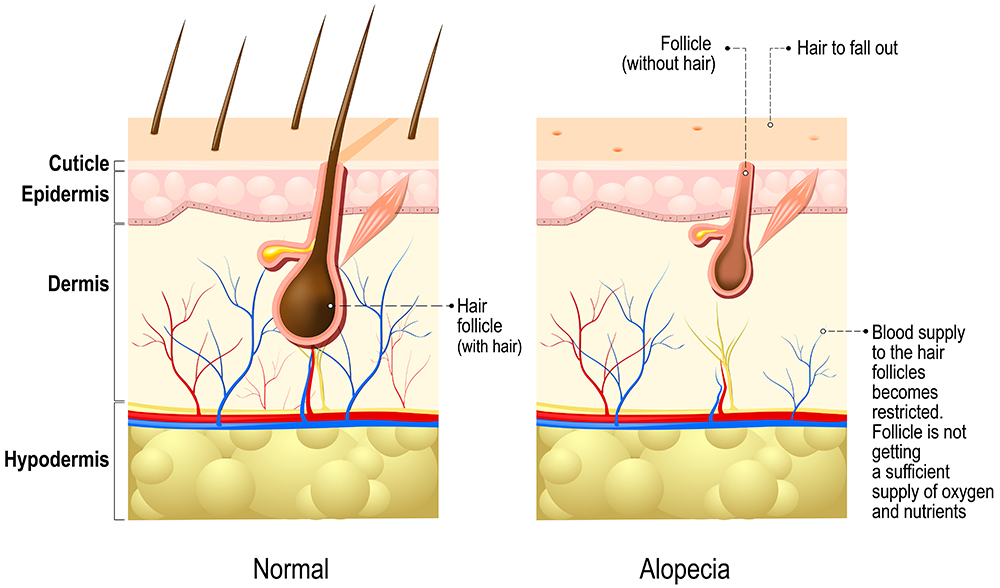
Female Hair Loss
We shed 50 to 100 hairs per day. For many people, this is not a noticeable amount of thinning because our hair follicles are at different stages, and new growth is occurring while others are shedding. When the hair growth cycle is disrupted, and shedding stimulated or the hair follicle becomes injured the follicle can eventually die, and replaced by scar tissue.
Androgenetic Alopecia is the gradual destruction of hair follicles coming from a genetic cause from either side of the parent, progression of age, and level of the specific male hormone, dihydrotestosterone (DHT). This single hormone is also known as the “killer of hair follicles,” prevents hair follicles from receiving vital nutrients for proper hair follicle growth, causing hairs too thin, and have a significantly shortened lifespan. The ratio of Estrogen to DHT is commonly the issue, with individuals that have lower estrogen levels and normal DHT levels suffering from this condition, as well as elevated DHT levels. Menopause creates hair thinning commonly from this adjustment in hormone ratios. Some hair follicles are genetically more sensitive to DHT than others creating the potential for early onset of hair thinning, and resulting in significant baldness.

TELOGEN EFFLUVIUM
Telogen effluvium is a sudden loss of hair from the result of more than 25% of hair follicles are prematurely being pushed into the resting state, commonly a result of a specific stressor. Commonly occurs in ages of 40-70, however, can occur at any age. The most common description is just merely a sudden loss and thinning of the hair. Often the cause is identifiable, and usually can be attributed to an acute or chronic medical condition, pregnancy, onset of menopause, nutritional status, anemia, thyroid dysfunction, medications, recent trauma or surgeries, and high levels of stress.
ARE YOU AT RISK FOR HAIR LOSS?
Knowing how to predict when someone will completely go bald, or begin to thin is a challenging and most likely impossible task. However, common genetic correlates can be a significant factor in considering the degree of the condition, and the probability of end-stage loss if no intervention is employed. Majority of women will suffer from hair loss in the front central aspect of their scalp, without injury to the hairline initially. Some can have a gradual onset, while others have episodic shedding. The earlier the onset, and the longer the loss occurs, then the higher the probability of severe hair loss over time. Age of onset most commonly occurs within the 40s, and the 50s decade of life, however, onset can occur as early as your 20’s for some women. The most crucial time to seek evaluation and treatment is at the onset of thinning, or lack of recovery after a known temporary cause; such as pregnancy.
PATTERNS OF LOSS
Determining your type of female pattern hair loss is relatively easy to identify. The American Academy of Dermatology has accepted the following scales, and are often used when discussing female loss:

Ludwig Scale (Most Common):
A 3 tier classification, mild-extensive-severe. The front and top of the scalp suffer from thinning while the frontal hairline remains preserved.

Sinclair Scale:
A 5 tier classification, with Grade 1 being normal, 100% of pre-puberty girls classify at this level, while only 50% of women at age 80 qualify for Grade 1. Grade 2 has a widening of the central part. Grade 3 has a widening of the central part combined with thinning on both sides of the central part. Grade 4 has diffuse hair loss over the top of the scalp. Grade 5 severe loss, and only occurs in 1% of women.

DIAGNOSIS OF FEMALE HAIR LOSS
Female hair loss can be multifactorial and have an array of causes. A consultation with PA Sophia Michelle, allows you to undergo an extensive evaluation of your medical history, physical hair health, and history of hair thinning, and evaluation of potential causes. A physical exam will evaluate the follicular pattern and health level of your follicles throughout your scalp. A detailed analysis of follicular growth and strength will frequently be an evaluation during therapy. PA Sophia Michelle will use an advanced camera to assess your hair distribution, thickness, and growth for each region of the scalp. If your evaluation raises concerns for a possible metabolic cause, a blood analysis will most likely be a recommendation. Failure with therapy may require a scalp biopsy, or if scarring alopecia is suspected.
FEMALE HAIR LOSS TREATMENT
Our mission is to help educate our clients and the community on the multiple options available to those suffering from hair thinning. Commonly, by the time someone has sought treatment for hair loss 50% of their follicles are no longer producing shafts. Sophia Michelle Aesthetics provides education on the types of therapies that genuinely work. Every individual will have a different optimal treatment plan; however many clients can all benefit from each of these nonsurgical therapies.
NONSURGICAL TREATMENTS
SURGICAL TREATMENT
For a small portion of patients may not reach their restoration hair goals with nonsurgical therapies, and those patients will receive a referral for possible hair transplantation surgery.
